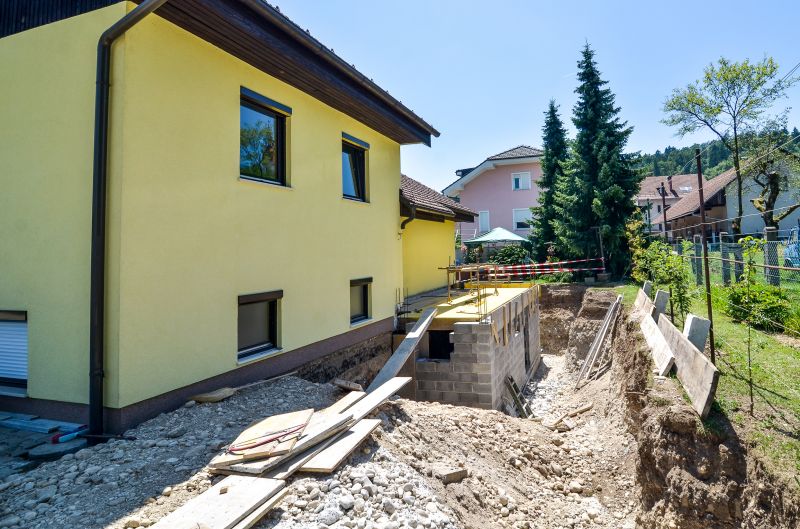Top-Rated Foundation Repair Products For Structural Confidence
Learn about high-quality products designed to resolve foundation issues and restore your home's strength and stability.
 Foundation issues can pose significant challenges for homeowners, especially in regions like Festus, MO, where soil conditions and weather patterns may influence structural stability. Addressing foundation concerns promptly is crucial to maintaining the safety and integrity of a building. There are various products available designed to stabilize, lift, and repair foundations, each suited to different types of problems and soil conditions. Understanding the range of options can help homeowners and contractors select the most appropriate solutions for their specific needs.
Foundation issues can pose significant challenges for homeowners, especially in regions like Festus, MO, where soil conditions and weather patterns may influence structural stability. Addressing foundation concerns promptly is crucial to maintaining the safety and integrity of a building. There are various products available designed to stabilize, lift, and repair foundations, each suited to different types of problems and soil conditions. Understanding the range of options can help homeowners and contractors select the most appropriate solutions for their specific needs.
Top Overall Option
Hydraulic Foundation Lifting System
A hydraulic foundation lifting system uses high-pressure hydraulic jacks to gently lift and stabilize sinking or settling foundations. These systems are versatile and can be adjusted to different load requirements, making them suitable for a range of foundation repair scenarios. When properly installed by professionals, hydraulic systems can provide a controlled and precise method to restore a foundation's original position, helping to prevent further structural issues.
Types of Products For Foundation Repairs
Hydraulic Jacks
Used for lifting and leveling foundations, hydraulic jacks provide adjustable support during repair processes.
Underpinning Piers
Concrete or steel piers are driven beneath the foundation to provide support and stability.
Helical Piles
Deep foundation supports screwed into the ground to stabilize and lift foundations in challenging soil conditions.
Epoxy Injection Kits
Used to fill and seal cracks in concrete foundations, restoring strength and preventing water intrusion.
Carbon Fiber Reinforcement
Fiber strips bonded to foundation walls to reinforce and prevent further cracking.
Soil Stabilization Products
Chemical solutions that improve soil compaction and reduce shifting beneath foundations.
Foundation Repair Braces
Metal braces installed to stabilize bowing or leaning foundation walls.
Waterproofing Membranes
Barrier materials applied to foundation walls to prevent water infiltration and related damage.
Pier and Beam Supports
Supports designed for homes with pier and beam foundations to lift and stabilize the structure.
Grouting Materials
Used to fill voids and stabilize soil around the foundation.
Foundation Repair Anchors
Anchoring systems that stabilize bowed or cracked foundation walls.
Concrete Patching Materials
For repairing surface cracks and minor damages on foundation surfaces.
Popular Choices
Commonly used for controlled lifting and leveling of foundations in residential repairs.
Popular for providing long-term support beneath sinking or settling foundations.
Frequently chosen for sealing cracks and preventing water ingress in concrete foundations.
Trusted for their ability to stabilize foundations in difficult soil conditions.
A favored option for reinforcing cracked basement or foundation walls.
Often used to improve soil stability around foundations, especially in expansive clay soils.
Popular for stabilizing bowing or leaning basement walls.
Widely used to protect foundations from water damage and moisture issues.
Commonly installed in pier and beam homes for added stability.
Frequently selected to fill voids and reinforce soil beneath foundations.
Popular for stabilizing cracked or bowing foundation walls.
Chosen for surface crack repairs and minor surface damages.
Foundation repair products encompass a broad spectrum of materials and systems. Some are intended for minor adjustments, while others are suitable for more extensive repairs. Commonly used items include hydraulic jacks, underpinning piers, helical piles, and epoxy injections. These products work in different ways—lifting, reinforcing, filling cracks, or stabilizing soil—allowing for tailored approaches based on the severity and nature of the foundation issues.
Choosing the right products involves considering factors such as soil type, extent of damage, accessibility, and long-term durability. Professional assessment is often recommended to determine the most effective repair strategy. Proper installation and high-quality materials are essential to ensure the longevity of the repair work. Homeowners should also be aware of the potential need for ongoing maintenance or monitoring after repairs are completed.
Investing in the right foundation repair products can help mitigate further damage and preserve the value of the property. While DIY solutions exist for minor issues, complex repairs generally benefit from expert guidance and specialized equipment. By understanding the options and considerations involved, residents of Festus, MO, can better navigate the process of maintaining a safe and stable foundation for their homes.
Key Buying Considerations
- Assess the severity and type of foundation issue to select appropriate products.
- Consider the soil conditions and how they impact foundation stability.
- Evaluate the load-bearing requirements for the repair system.
- Determine whether a DIY approach is feasible or if professional installation is recommended.
- Check the compatibility of repair products with existing foundation materials.
- Review the long-term durability and maintenance needs of the chosen products.
- Ensure proper installation procedures are followed for safety and effectiveness.
- Consider the accessibility of the repair site and the size of equipment needed.
- Look into warranty options or guarantees offered with repair products.
- Factor in the potential for future inspections or monitoring after repairs.
- Identify products that allow for adjustments or re-leveling if needed.
- Prioritize high-quality materials to reduce the risk of future issues.
- Be aware of local building codes and regulations related to foundation repairs.
- Consult with a foundation specialist for tailored recommendations.
- Evaluate the cost-effectiveness of different repair options over time.
